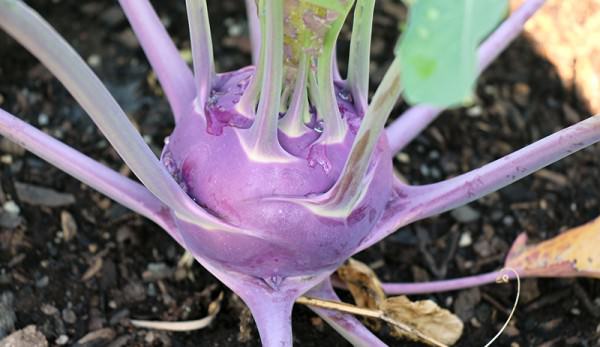
Because kohlrabi can be stored in a root cellar for long periods of time, it was once a very popular vegetable crop. Once refrigeration became standard in every household, this cole crop’s popularity fell. Thankfully, kohlrabi is being rediscovered by foodies and farmers-market customers everywhere, and its popularity is once again on the rise.
Kohlrabi’s flavor is mildly sweet and reminiscent of its close cousin, cabbage. Although it’s often called a bulb, the edible portion of this vegetable is actually its swollen, above-ground stem. Kohlrabi can be eaten both raw and cooked, and the flesh is filled with fiber, potassium and vitamin C. My family enjoys kohlrabi sliced in salads, grated into slaw, breaded and fried, and puréed into a soup.
Spring Planting
For an early spring harvest of this cool-season crop, you can start seeds indoors under grow lights about four to six weeks before your last expected spring frost. Seeds should be sown about 1/4-inch deep in a pot or nursery flat filled with sterile potting mix. Transplant the seedlings into small pots as soon as they form their fist true leaves. They can then be moved out into the garden as soon as the nighttime temperatures are consistently above 30 degrees F.
You can also grow kohlrabi by directly seeding them into the garden as soon as the soil can be worked in the early spring. Seeds should be spaced 2 inches apart and covered with a light layer of soil. Once the seedlings reach 1 inch high, thin them to 4 inches to allow plenty of room for growth.
A Fall Crop, Too
Although kohlrabi is a popular spring crop, here in my USDA zone 6 garden, I also enjoy growing it for fall and winter harvests. To grow a crop of late-season kohlrabi, sow seeds directly into the garden in late July or early August. Most varieties take between 60 and 65 days to mature, though you can harvest them as soon as the swollen stem reaches the size of a tennis ball.
Like other cole crops, kohlrabi is quite tolerant of frosts and cold weather. To protect my fall crop from frosts, I cover the plants with a layer of floating row cover or plant them into my cold frame. If the temperatures don’t dip too low, I can continue to harvest kohlrabi well into the winter. Their crisp texture is awesome in winter salads.
Keeping Cabbage Worms At Bay
The kohlrabi in my garden are often plagued by imported cabbage worms. These little green caterpillars quickly skeletonize the leaves and weaken the plants. To control them, I handpick the caterpillars whenever I spot them and feed them to our chickens. When there are too many to handpick, I use the organic biological pesticide Bt (Bacillus thuringiensis) to help keep them in check.
Choosing A Kohlrabi Variety
The purple-skinned varieties Delicacy Purple, Blaril and Azur Star are among my favorites, but my husband prefers standard, white-fleshed varieties, like Korridor and Superschmelz.
If you haven’t grown kohlrabi before, or if you’ve only grown them as a spring crop, head out to the garden in late summer and try your hand at growing a late-season crop. There’s something extra special about winter harvests of this delicious oldie-but-goodie.




